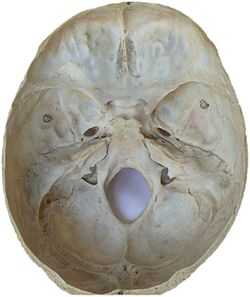Neurocranium
| Neurocranium | |
|---|---|
 | |
| Neurocranium | |
 | |
| Base of skull | |
| Latin | Neurocranium |
| Gray's | p.128 |
| TA | A02.1.00.007 |
| FMA | FMA:53672 |
In mammals, the neurocranium, braincase, or brainpan [1] (also spelled brain-pan[2]) is the back part of the skull and houses the brain. In front of it is the interorbital region.
In humans, the neurocranium is (also) the upper portion of the skull. The other, lower part of the skull is the viscerocranium.
Evolutionarily, the human neurocranium has turned from being (just) the back part to (also) being the upper part, because during the evolutionary expansion of the brain, the neurocranium has overgrown the viscerocranium. The upper-frontmost part of the cranium also houses the evolutionarily newest part of the human brain, the frontal lobes.
The term "cranium" can be ambiguous in that it can refer to the neurocranium, or the whole skull, meaning the neurocranium and the facial skeleton.
Structure
The size of the braincase is variable among mammals. The roof may contain ridges such as the temporal crests. Below the braincase is a complex of foramina (openings) and bones, including the foramen magnum which houses the neural spine. The auditory bullae, located in the same region, aid in hearing.[3]
The neurocranium is formed by the endocranium, the lower portions of the cranial vault, and the skull roof. These are not fused in fishes, and a proper neurocranium is only found in land vertebrates.
Human neurocranial bones
In humans, the neurocranium is usually considered to include the following eight bones:
The ossicles (three on each side) are usually not included when enumerating the bones of the neurocranium.[5] There may variably also be extra sutural bones present.

Embryonic origins
The neurocranium arises from paraxial mesoderm. There is also some contribution of ectomesenchyme. In Chondrichthyes and other cartilaginous vertebrates this portion of the cranium does not ossify; it is not replaced via endochondral ossification.
See also
- Base of the skull
References
- ↑ "Brainpan - Medical Definition and More from Merriam-Webster". Merriam-Webster/Medical.
- ↑ Nyiszli, Miklos (2011). Auschwitz: A Doctor's Eyewitness Account. New York: Arcade Publishing.
- ↑ Elbroch, M. 2006. Animal skulls: A guide to North American species. Stackpole Books, pp. 20–22. ISBN 978-0-8117-3309-0
- ↑ In small children, the frontal bone is still separated into two parts, by the frontal suture, which normally closes during postnatal development.
- ↑ but if they are included, the neurocranium will then have to be said to consist of fourteen bones
| ||||||||||||||||||||||||||||||||||||||||||||||||||||||||||||||||||||||||||